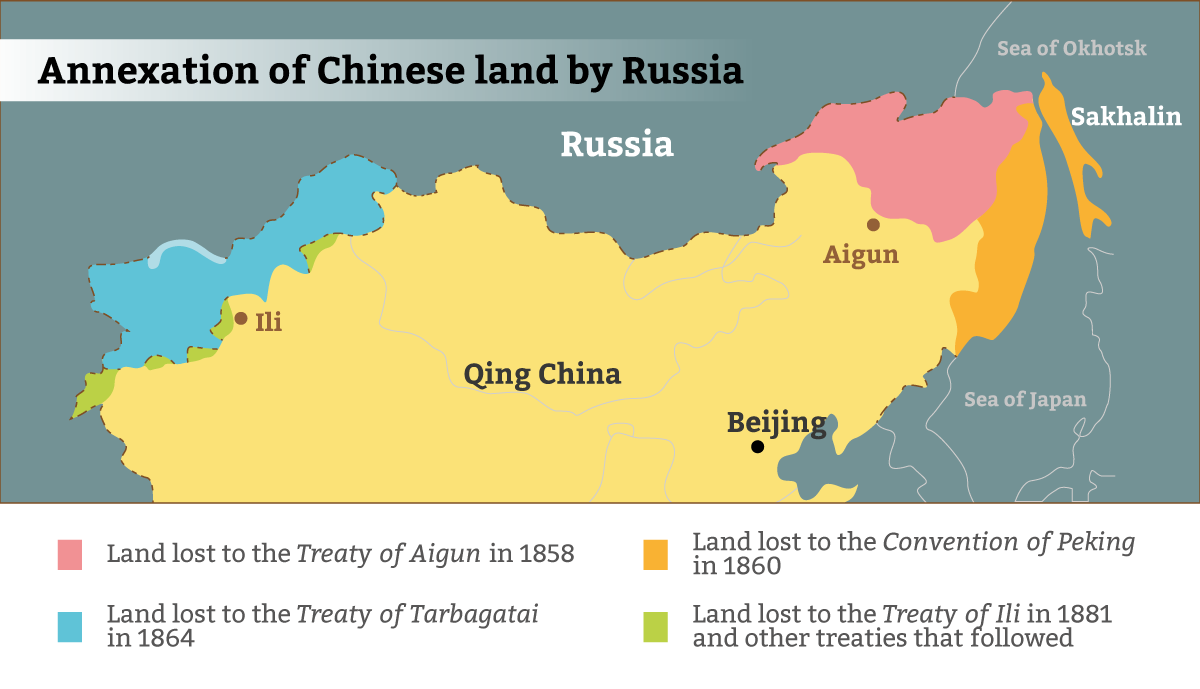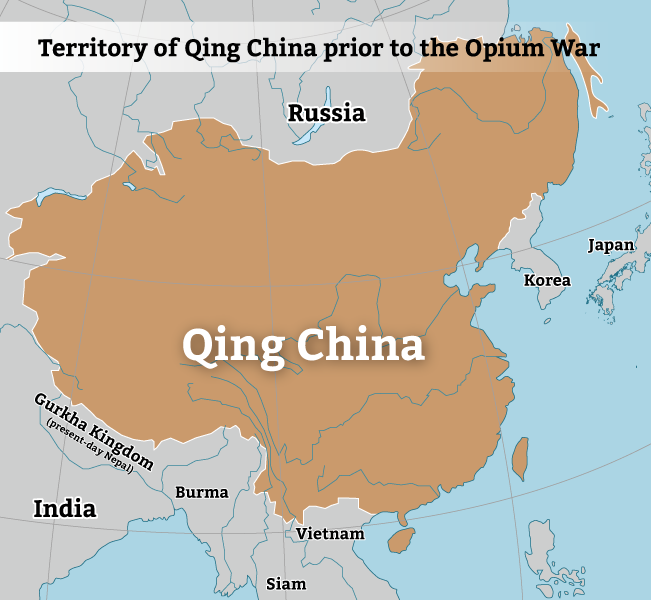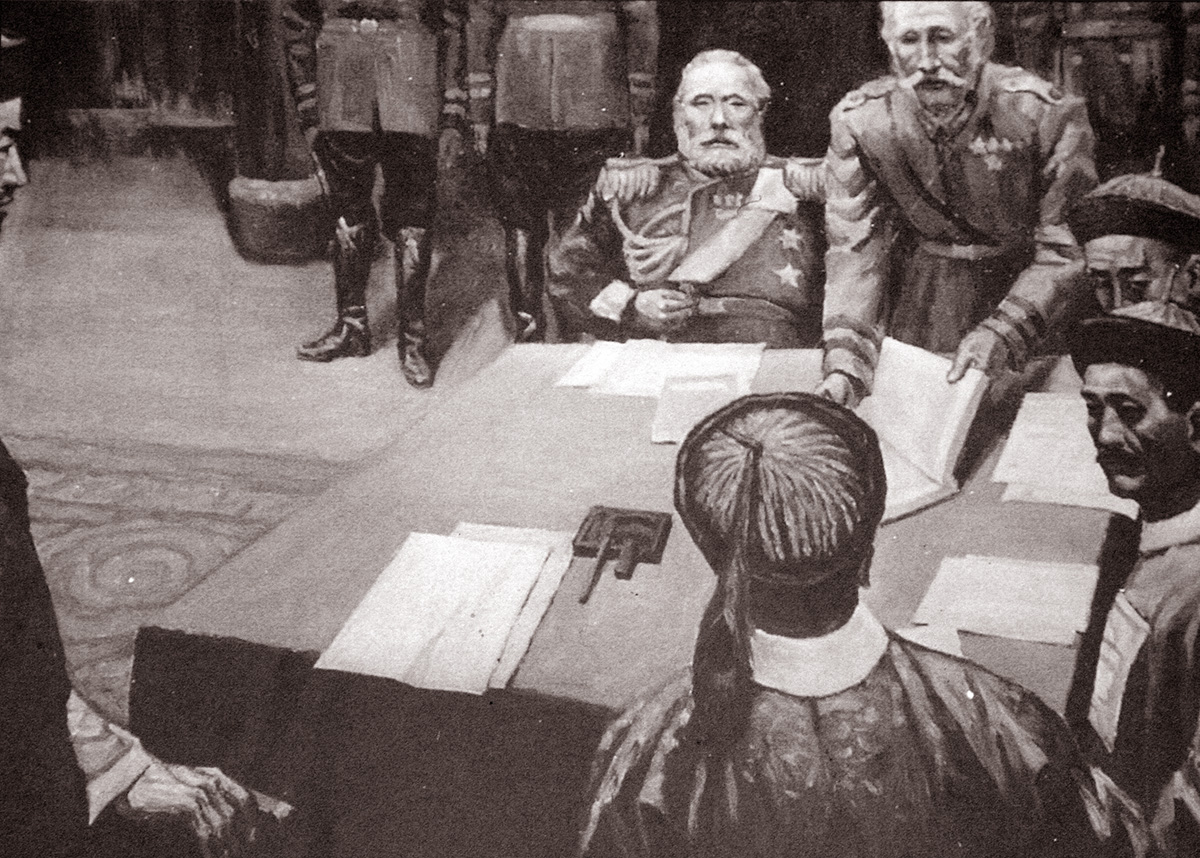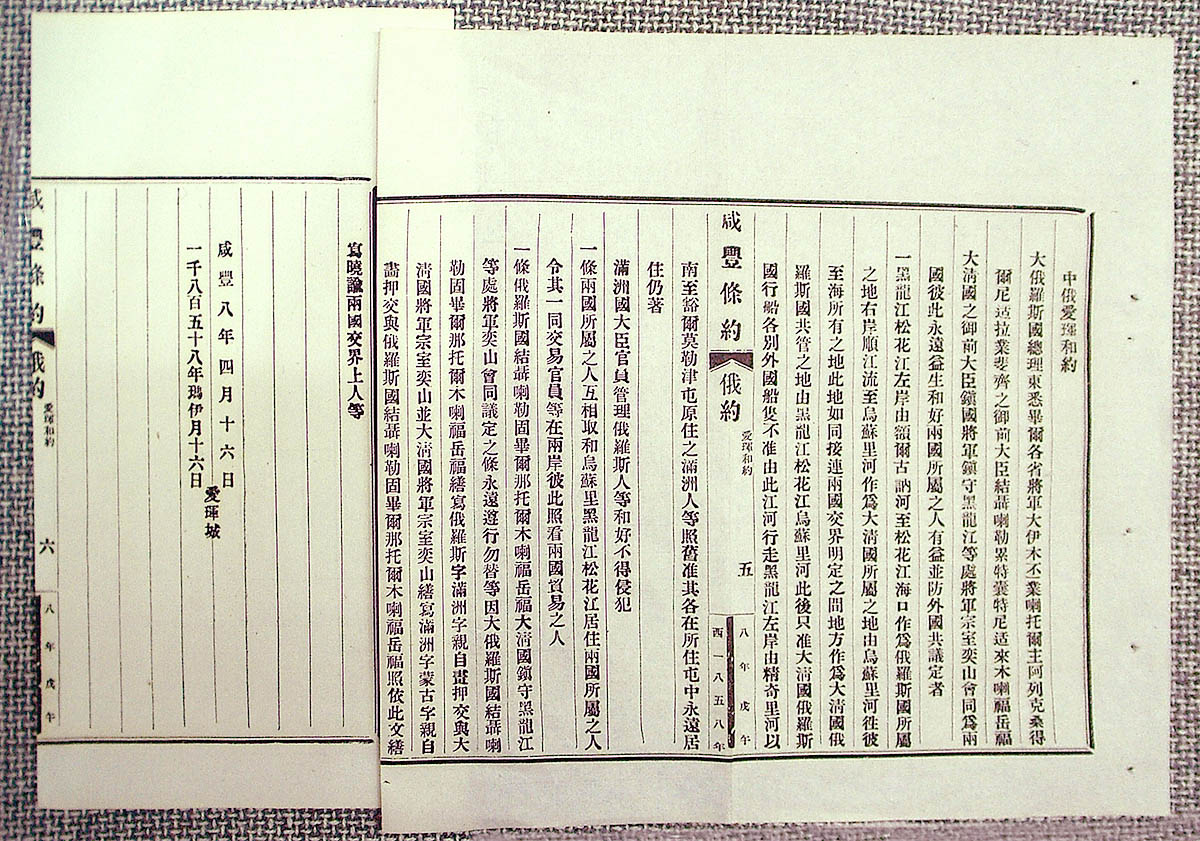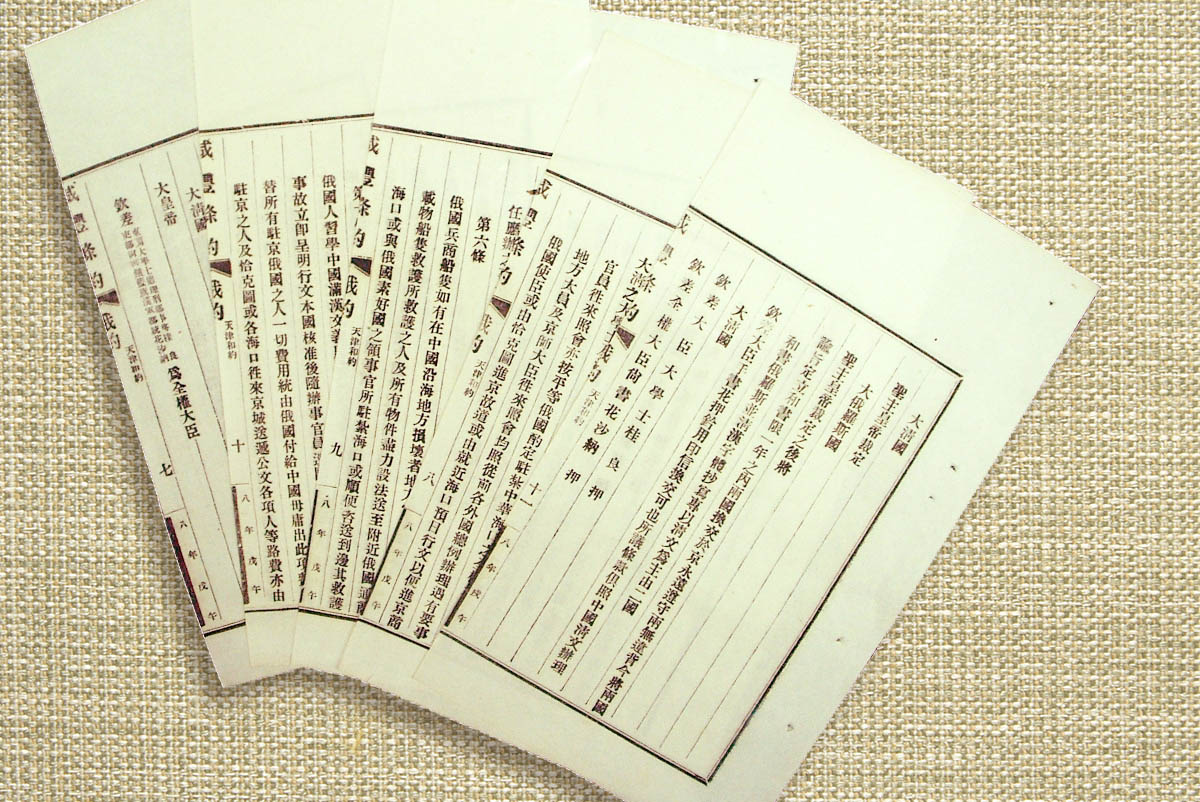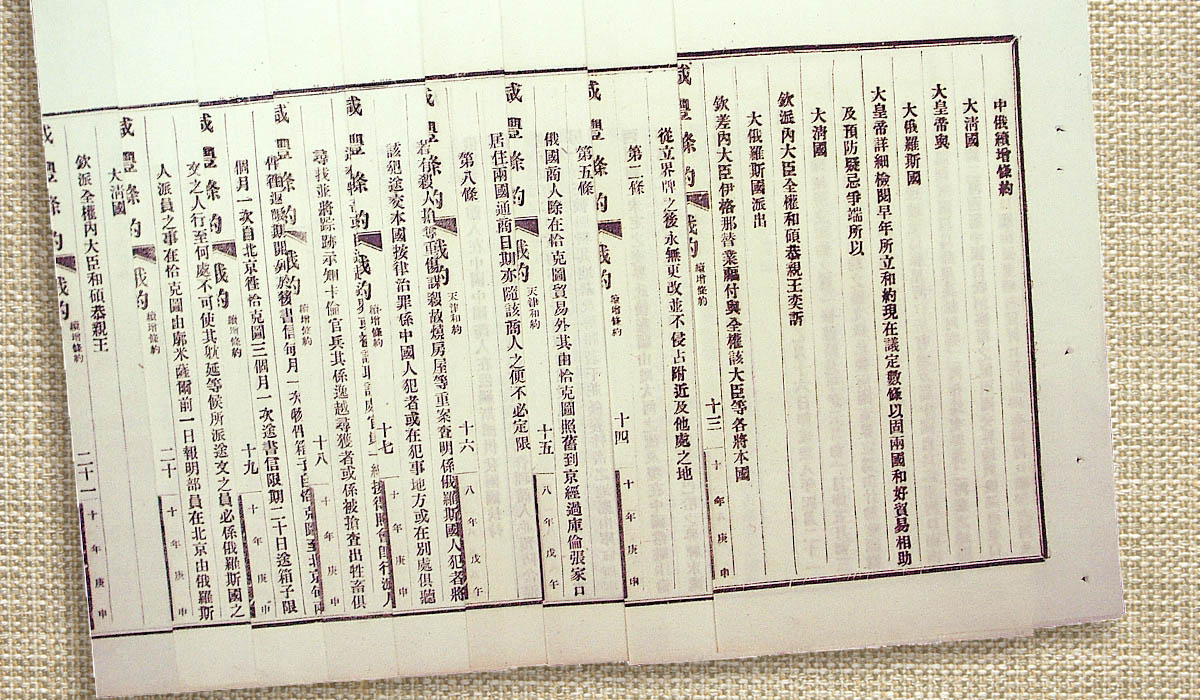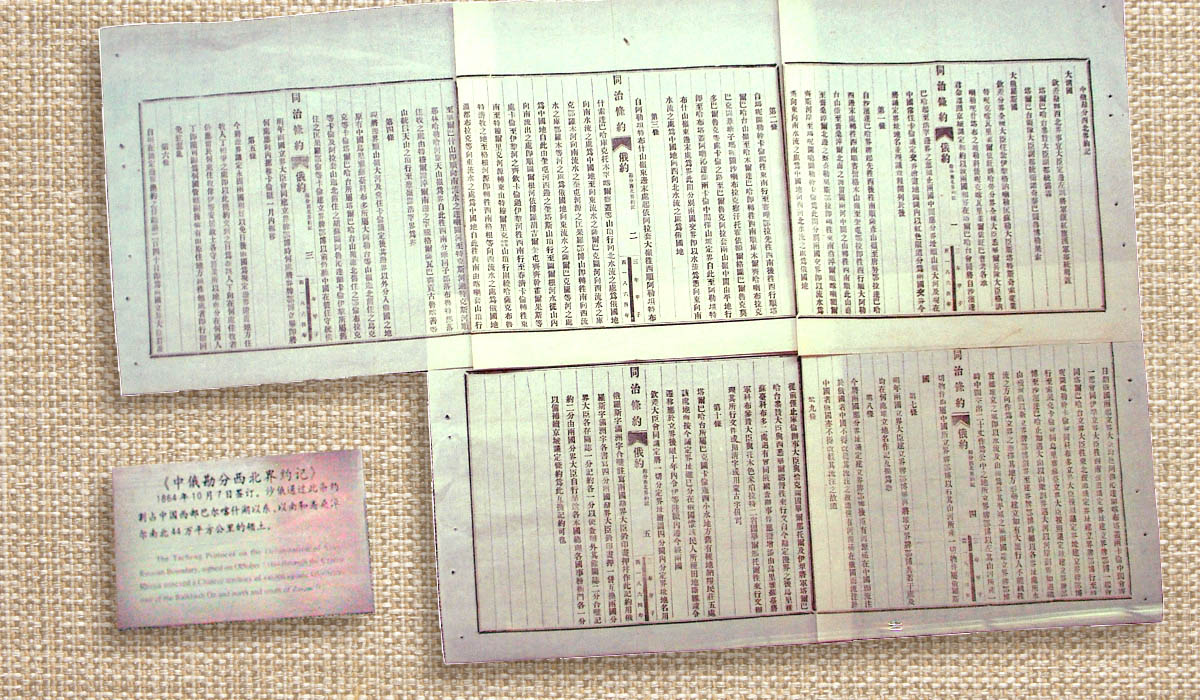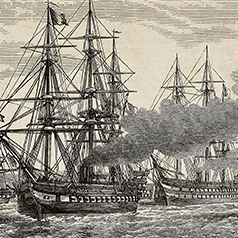While the Anglo-French Expedition to China was being waged, Russia had just suffered a setback in the Crimean War and the United States was on the brink of a civil war between its northern and southern states. Thus, both countries sat out the conflict. Nevertheless, they took advantage of China’s weakness to benefit themselves. Posing as a “mediator”, Russia demanded vast Chinese territory as a reward for its “services”. The Qing government, still ignorant about foreign affairs despite all that happened since the Opium War, thus suffered huge loss from it.
Before China signed the Treaties of Tientsin (《天津條約》, Treaties of Tianjin) with Britain and France on 26 and 27 June 1858, Russia had already pressured China into signing the Sino-Russian Treaty of Aigun (《璦琿條約》), which placed vast Chinese territory in Russian hands. On 13 and 18 June, Russia and the United States, acting separately, signed the Treaties of Tientsin with China ahead of Britain and France. This significantly furthered their interests in China. On 14 November 1860, following the signing of the Sino-British and Sino-French Conventions of Peking (《北京條約》, Conventions of Beijing), Russia forced the Qing government to sign a Sino-Russian Convention of Peking with them as well. Altogether, the various Sino-Russian treaties - the Treaty of Aigun, the Treaty of Tientsin, the Convention of Peking, and the later Treaty of Tarbagatai (《勘分西北界約記》) - enabled Russia to seize around 1.5 million square kilometres of the Chinese territory.
|
|
Would it be accurate to call Russia the biggest winner of the Anglo-French Expedition to China? |
|
|
See answer below. |
The territory of Qing China in the 19th century, prior to the Opium War. After the Opium War, the rapid decline of the Qing regime fuelled the ambitions of its neighbouring power, Russia, which started plotting to seize China’s northern territory as its own.
Starting from May 1858, Russia took advantage of China’s preoccupation with the Anglo-French invasion to position troops at the Sino-Russian border. Presenting its military as a new threat and posing as a “mediator”, Russia forced China to sign a series of unequal treaties that ceded vast area of its territory to Russia. The picture shows Chinese and Russian representatives negotiating in Aigun.
On 28 May 1858, China and Russia signed the Treaty of Aigun, which placed over 600,000 square kilometres of the Chinese territory north of Heilongjiang (黑龍江, also called Amur River) and south of the Stanovoy Range (外興安嶺) under Russian control; the Chinese territory east of the Ussuri River (烏蘇里江) was placed in “joint administration” by the two countries, and the Amur and Ussuri rivers, both China’s inland waterways, were opened to Russian ships.
The Kuixing Pavilion (魁星閣), where the Sino-Russian Treaty of Aigun was signed, still stands in the Old City of Aigun in Heilongjiang Province’s Heihe City (黑龍江省黑河市), a silent testament to the historic event that led to a devastating loss of Chinese territory.
The original Sino-Russian Treaty of Tientsin. On 13 June 1858, China was forced to sign this treaty, which granted Russia numerous concessions such as treaty port trading rights, extraterritoriality, a most-favoured-nation clause, and the right for Russians to evangelise in China. An article in the treaty provided for the appointment of special commissioners to draw the demarcation lines for the undefined sections of the Sino-Russian border. This would later allow Russia’s further encroachment upon Chinese territory.
The original Treaty of Peace, Amity, and Commerce between the United States of America and China (中美《和好條約》), also known as the Sino-US Treaty of Tientsin. On 18 June 1858, China was forced to sign this treaty, granting the United States numerous concessions such as a most-favoured-nation clause, protection for American citizens and vessels, treaty port trading rights, and the right for Americans to evangelise in China.
Pictured is the Sino-Russian Convention of Peking signed on 14 November 1860. This treaty forced China to cede to Russia around 400,000 square kilometres of territory east of the Ussuri River. In the previous Treaty of Aigun, it had been designated as the territory jointly administered by China and Russia.
Russia attained the territory east of the Ussuri River under the Sino-Russian Convention of Peking. The Ussuri River, once an inland waterway of China, became the border river between China and Russia. Pictured is the modern-day Ussuri River, which demarcates the Sino-Russian border, as seen from the Chinese side. A Russian town can be seen across the border.
The original Treaty of Tarbagatai. Signed on 7 October 1864, the Treaty of Tarbagatai provided the means for Russia to claim as their own some 440,000 square kilometres of the Chinese territory that lay east and south of Lake Balkhash, and north and south of Lake Zaysan.
While the Qing government was distracted by the invasion of the Anglo-French alliance, Russia took the opportunity to force China to sign a series of unequal treaties through which Russia succeeded in extorting 1.5 million square kilometres of the Chinese territory. Later, it seized a further 70,000 square kilometres of Chinese territory via the 1881 Sino-Russian Treaty of Ili (《伊犁條約》, also known as the Treaty of Saint Petersburg《聖彼得堡條約》) and other treaties that followed.
|
|
Would it be accurate to call Russia the biggest winner of the Anglo-French Expedition to China? |
|
|
In terms of territories annexed alone, and not counting other benefits, Russia was indeed the biggest winner. Throughout history (except for the early modern era of Western imperialism) foreign tribes dwelling in the steppes north of China, such as the Xiongnu (匈奴), Xianbei (鮮卑), Turkic (突厥), Khitan (契丹), Jurchen (女真), and Mongol peoples, had posed the greatest threat to the Chinese regimes based in the Central Plains. In the early modern era, Russia, abutting China in the south, was the country that could most easily take advantage of the Qing regime’s weakness to seize China’s vast northern territories as its own. Lin Zexu (林則徐), while surveying the land of Xinjiang (新疆), once pointed out, “Dealing with Britain is easy; it is Russia that will be the ultimate threat to China!” With Russia’s later seizure of vast swathes of the Chinese territory, Lin ’s warning proved to be prescient. |
Source of most photos used in this feature piece: Fotoe




